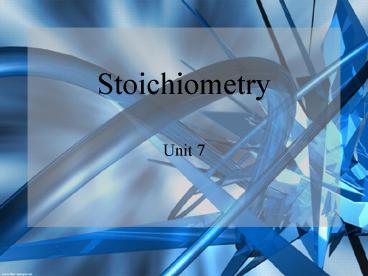Stoichiometry - PowerPoint PPT Presentation
1 / 15
Title:
Stoichiometry
Description:
Stoichiometry. What if you have 40 graham crackers, 30 chocolate squares, and 20 marshmallows? ... Stoichiometry. Solving Limiting Reagent Problems ... Stoichiometry ... – PowerPoint PPT presentation
Number of Views:39
Avg rating:3.0/5.0
Title: Stoichiometry
1
Stoichiometry
- Unit 7
2
Stoichiometry
- To make a smore, you need 2 graham crackers, 3
squares of chocolate, and 1 marshmallow. - If you have 20 graham crackers, 30 chocolate
squares, and 10 marshmallows, how many smores can
you make?
3
Stoichiometry
- What if you have 40 graham crackers, 30 chocolate
squares, and 20 marshmallows? - What if you have 18 graham crackers, 30 chocolate
squares, and 10 marshmallows?
4
Stoichiometry
- Limiting Reagent
- Limits (determines) the amount of product that
you can get - Excess Reagent
- Reagent that there is more than enough of
- There is extra leftover when the reaction is
complete
5
Stoichiometry
- Just like the smores, the same thing happens in
chemical reactions. - Example
- 2 H2 O2 ? 2H2O
H2 is L.R.
O2 is E.R.
4 molecules H2
3 molecules O2
6
Stoichiometry
- Solving Limiting Reagent Problems
- If 18.1 g NH3 is reacted with 90.4 g of CuO,
which is the limiting reagent and how many grams
of solid copper will be produced?
7
Stoichiometry
- Balance the equation.
- 2 NH3 3 CuO ? N2 3 Cu 3 H2O
- 2. Pick 1 of the reactants and 1 of the products.
(Pick the product you are being asked about.)
Using the given amount of reactant, figure out
how much product you get. (3 steps)
8
Stoichiometry
1 mol NH3
63.55 g Cu
3 mol Cu
18.1 g NH3
2 mol NH3
1 mol Cu
17.04 g NH3
101 g Cu
9
Stoichiometry
- 3. Now take the other reactant, and repeat Step 2
with the same product you used before. (3 steps)
1 mol CuO
63.55 g Cu
3 mol Cu
90.4 g CuO
3 mol CuO
1 mol Cu
79.55 g CuO
72.2 g Cu
10
Stoichiometry
- 4. Which reactant gave you less product?
- CuO
- 5. Thats the one that will run out first, so
that is your limiting reactant. - 6. Now, using your LIMITING REACTANT, go back and
answer the original question. - 72.2 g Cu
11
Stoichiometry
- Examples
- 2 H2 O2 ? 2 H2O
- Determine the limiting reactant in each case.
12
Stoichiometry
- a. 4.0 g H2 reacts with 3.0 g O2
1 mol H2
18.02 g H2O
2 mol H2O
4.0 g H2
2 mol H2
1 mol H2O
2.02 g H2
36 g H2O
1 mol O2
18.02 g H2O
2 mol H2O
3.0 g O2
1 mol O2
1 mol H2O
32.00 g O2
O2 is L.R.
3.4 g H2O
13
Stoichiometry
- b. 10.0 g H2 reacts with 10.0 g O2
1 mol H2
18.02 g H2O
2 mol H2O
10.0 g H2
2 mol H2
1 mol H2O
2.02 g H2
89.2 g H2O
1 mol O2
18.02 g H2O
2 mol H2O
10.0 g O2
1 mol O2
1 mol H2O
32.00 g O2
11.3 g H2O
O2 is L.R.
14
Stoichiometry
- c. 15.0 g H2 reacts with 10.0 g O2
1 mol H2
18.02 g H2O
2 mol H2O
15.0 g H2
2 mol H2
1 mol H2O
2.02 g H2
134 g H2O
1 mol O2
18.02 g H2O
2 mol H2O
10.0 g O2
1 mol O2
1 mol H2O
32.00 g O2
11.3 g H2O
O2 is L.R.
15
Stoichiometry
- d. 5.0 g H2 reacts with 30.0 g O2
1 mol H2
18.02 g H2O
2 mol H2O
5.0 g H2
2 mol H2
1 mol H2O
2.02 g H2
45 g H2O
1 mol O2
18.02 g H2O
2 mol H2O
30.0 g O2
1 mol O2
1 mol H2O
32.00 g O2
33.8 g H2O
O2 is L.R.































